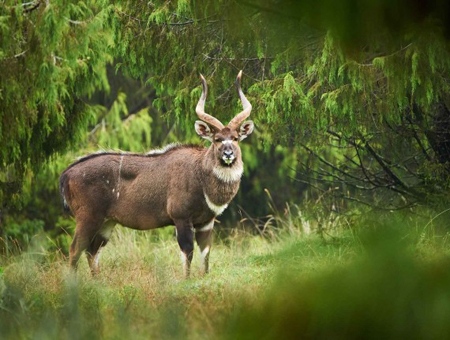In contrast to Ethiopia’s lush landscapes in its entirety, very little was written about the Bale Mountains prior to 1950. But this famous mountain has quickly become one of the best ways to trek Ethiopia.
History of the Bale Mountains National Park

The Bale Mountains were formed from lava outpourings which covered all the underlying rock formations between 38 and 7million years ago. As records began to appear at the beginning of the 20th century, the first recorded visit was by the German explorer and naturalist, Carlo Von Erlanger who reached the Bale Mountains between 1891 and 1901. He documented the existence of the giant mole-rat. Afterward, Vicomte du Bourg, a Frenchman spent two months in Goba in 1901 and he noted the presence of elephants and buffalos in the Harenna forest and also commented on the ivory hunting in the area.
There was no record afterward until late 1950 when Finnish geographer, Helmer Smels arrived in Bale. Smels made three journeys to Bale and crossed the area from Goba, through Rira to Delo-Mena. 50 years after Vicomte du Bourg had noted the presence of elephants, Smels noted they had all disappeared from the Harenna forest and that although the Sanetti plateau was uninhabited, people drove their cattle to the plateau for grazing during the dry season, sometimes up to three months.
The impetus for the present national park started with two visits to the area in 1963 and 1965 by the British naturalist, Dr. Leslie Brown. His major recommendation was that a national park to be established in the Bale Mountains to protect their habitat. Dr. Brown’s recommendation was followed through and in 1969, the Bale National Park was established.
What to expect

Located in southeastern Ethiopia, the Bale Mountains National Park sits 400 km southeast of Addis Ababa and is 150 km east of Shashamene in the Oromia Region National State. It encompasses an area approximately 2,150 sq m (530,000 acres) in the Bale Mountains and Sanetti plateau of the Ethiopian Highlands. Things to see include:
Fauna and Avifauna
The Bale Mountains is an important area for a lot of threatened Ethiopian endemic species. The Bale Mountains are also home to over 282 species of birds including 9 0f the 16 species endemic to Ethiopia.
Rare Animals
The park holds 26% of Ethiopia’s endemic species including one primate, one bovid, one hare, eight rodent species, the entire global population of the big-headed African mole-rat, and also several rare and endemic amphibians. Mammal species in the Bale Mountains National Park include the Ethiopian wolf, Mountain nyala, bush rock, klipspringer, warthog, Serval, and the Bale Mountains vervet. Other mammals include cape bushbuck, African golden wolf, colobus monkeys, lions, African leopard, and wild dog. Almost one-third of the 47 mammals that live in the Bale Mountains National Park are rodents.
Flora
The Bale Mountain National Park is home to 1321 species of flowering plants. Its forests are important for genetic stocks of wild forest coffee and medicinal plants in Ethiopia.
Views and Sceneries

The Bale Mountains National Park comprises of five major vegetation zones.
Northern Grasslands (Gaysay Grassland)
Spanning the Web and Danka rivers, the northern grasslands are situated to the south of the Bodeti Mountain, north of Adelay ridge, and northwest of Dinsho. The higher areas of northern grasslands are scrubby with African wormwood and cape gold. One of the more than ten species of everlasting flower bound is found in Bale. wild fennel grows here and the Hagenia abyssinica female trees boast an impressive red bloom. It is the best place for viewing the endemic nyala, sometimes up to 50 in a herd.
Afroalpine Meadows (Sanetti plateau and Upper Web Valley)
Plant diversity here is low due to the altitude but one of the notable species is the giant lobelia. Afroalpine rodents dominate the cold and barren plateau especially the giant mole-rat, rock hyrax, and Starck’s hare. The plateau also hosts a large number of raptors that feed on the rodents including the bearded vulture, lanner falcons, kestrels and augur buzzards. The rivers, lakes, and swamps attract many pale arctic warders like the blue-winged goose, Spot-breasted plover, and ruddy shelduck.
Erica belt (Moorland and Forest)
Located immediately above the treeline is a belt of heather made up of species of the Erica and Philippa genera dominated specifically by Erica arborea. The trees in the Erica belt are highly endangered and are quite rare in Ethiopia and the forests are a fairytale wood of giant heather dressed in moss and old man’s beard (lichen). Menelik’s bushbuck, mountain nyala, and grey duiker reside here in relatively large numbers. Male and female Klipspringers that have horns can only be found in the Bale Mountains.
Harenna Forest
The Harenna forest is the second largest forest in Ethiopia and the largest area of the park. The Rubus steudneri, a member of the blackberry family grows along the road from April to June. The elusive animals of the Harenna forest have little trouble staying hidden because the forest is so dense and clearings are fewer and far between. Olive baboon, black-and-white colobus monkeys, warthog, and Menelik’s bushbuck are common and clearings are the best places to look for lions, leopards, and African wild dogs.
Quick Trekking Guide
Trekking the Bale Mountains National park starts from Dinsho to Adelay via the Geysey Valley and the Web river, viewing the Web waterfall along the way. Trekking usually takes 4-5 hours a day and may range from one to 12 nights.
The Bale Mountains National Park is open all year round, though the most popular time to visit is November through April when the rains have stopped. If you ever find yourself in Ethiopia, do not hesitate to include a visit to the Bale Mountains National Park.

